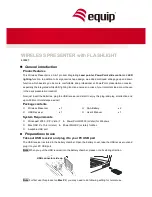
238
THE HASSELBLAD MANUAL
mount. It is the lens designer’s job to fi nd a combination that reduces all aberrations to a point
where they are not visible or objectionable in the applications for which the lens is made.
Number of Lens Elements
Although large aperture, extreme wide angle and zoom lenses require more elements, the
number of elements does not indicate the quality — a larger number of lens elements do not
mean a better lens. The quality is determined by the designer’s skill in combining a number of
elements to produce the maximum in quality using the latest types of glass and design
techniques. The quality of the fi nished lens is further determined, perhaps even more, by the
accuracy with which each lens element is ground and polished, the accuracy and workman-
ship that goes into each mechanical component of the lens mount, the precision that is used
in assembling the components, and the time and care taken in testing the fi nished lens.
Aspheric Lens Elements
Some lens designers have found easier ways to correct some of the lens aberrations by mak-
ing some lens elements with aspherical surfaces rather than the “ordinary” spherical type.
Such lenses are usually promoted by the companies as more modern and producing better
image quality than competitive lenses designed with the “old fashioned” spherical lens ele-
ments only. A lens with aspherical lens elements certainly may produce excellent image qual-
ity but not necessarily because it has aspherical lens elements. Another lens designer may
come up with a lens design with spherical elements only that may have equal or even better
quality. In other words, it is not the aspherical lens design that makes a better lens, it is the
skill of the lens designer and the precision in the manufacturing process. Manufacturers try
to stay away from aspherical lens elements as they are very diffi cult to produce and include
them only if the lens designer fi nds no other way to come up with a high quality lens design.
Lens Quality Information
Lens quality used to be expressed by the number of lines per millimeter a lens is capable of
reproducing as separate lines (see Figure 14-3). Lens and photo technicians have, however,
found that the sharpness in a photograph is not determined so much by the resolution of fi ne
detail as by the edge sharpness of lines within the image. This is known as acutance. Acutance
values correlate very well with the observer’s impression of sharpness.
Image-forming qualities are expressed with modulation transfer function (MTF) diagrams,
which are published in identical fashion for all the lenses in the V and the H systems and are
available from Hasselblad. These diagrams can be helpful for comparing the performance of
different Hasselblad lenses, to see whether the sharpness varies between close and far dis-
tances, or to what degree image sharpness changes when the aperture is closed down.
On the MTF diagrams (Figure 14-3), the center of the image is on the left. Each vertical
line represents 10 mm, so the far right is 40 mm from the center. The corners of the 2¼-in.
(6
6 cm) square are at 39 mm, at 35 mm for the 6
4.5 format, at 31 mm for the large 36.7
49.0 sensor, at 28 mm for the 33.1
44.2 size, and at 26 mm for the 36.7
36.7 version.
Summary of Contents for Digital Camera
Page 1: ......
Page 2: ...The Hasselblad Manual ...
Page 3: ...This page intentionally left blank ...
Page 13: ...This page intentionally left blank ...
Page 166: ...Heidi Niemala Photographed for clothing designer with a 150mm lens ...
Page 167: ...Heidi Niemala Editorial portrait with a 150mm lens ...
Page 168: ...Heidi Niemala Photographed with a 50mm lens during a sand storm at White Sands ...
Page 200: ...Jonathan Exley Lifestyle Designer Kathy Ireland Courtesy of kathyireland com ...
Page 244: ...Marco Grob A make up test shot made with an HC Macro 4 120mm lens on an H camera ...
Page 398: ...Close Up Photography on Film or Digital 383 ...
Page 400: ...Jonathan Singer ...
Page 401: ...Jonathan Singer ...
Page 421: ...This page intentionally left blank ...
















































